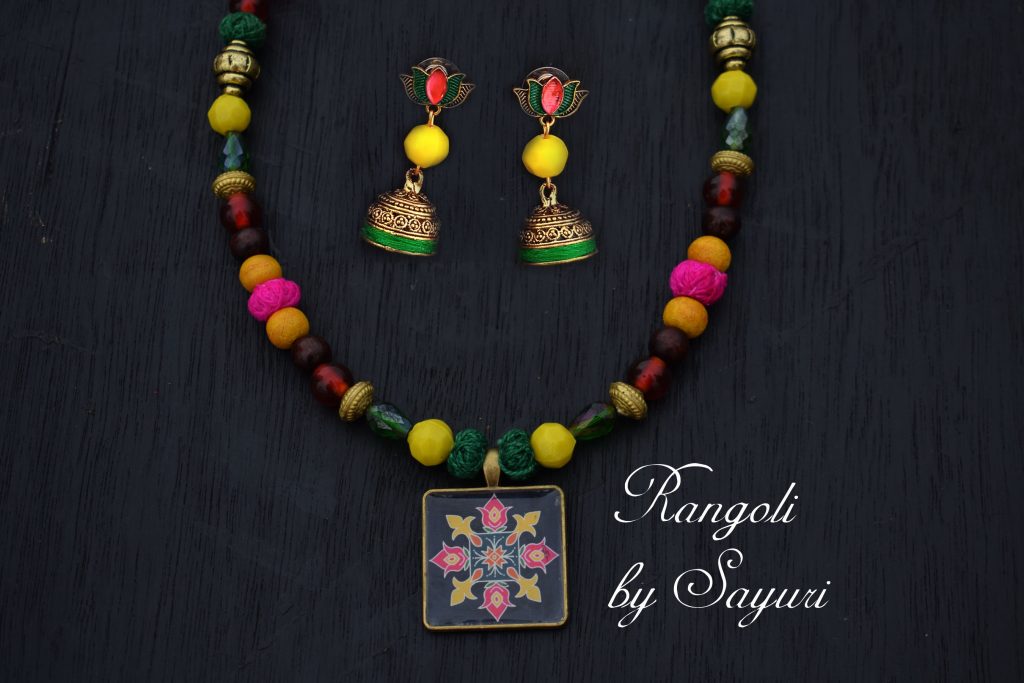Pongal or Sankranthi is the Indian version of Thanksgiving. It is a harvest festival (Jan 14th and 15th this year) where we give thanks to the Sun (and nature in totality) for blessing us with a bountiful harvest. After the month of Margazhi which is reserved for devotion and contemplation, the month Thai is for celebration. There is a saying in Tamil which when translated goes like this “When Thai arrives, a way to solve all your problems will be born as well”. Houses are decorated and people wear brightly coloured clothes during the festival. As Rangoli (colourful kolams) are a given, I thought that it would be interesting to showcase unique jewellery based on Rangoli. I call them my Pongal and Sankranti Rangoli Jewellery.

Rangoli for Pongal and Sankranthi
In my old post on Birth of a new dawn, I had shown a colour palette of earthy colours like rust, green, and sand to show ties to nature. However, I had also mentioned that Pongal is typically associated with bright colours.
Pongal or Sankranti is a harvest festival where people give thanks to nature. Thus in the Rangolis – flowers, leaves, the sun, cattle, sugarcane, pots and pans and the land are showcased. Those who cannot draw figurines atleast represent this forms using their main colours. They are often drawn in a Tetradic colour scheme (two sets of complementary colour on the colour wheel). This colour scheme stands for life and celebration of life. This explains why the kolams are so colourful.
Pongal and Sankranti Rangoli Jewellery
Designers are taught to plan ahead and work atleast a season in advance. So When I was working on my Patinum collection, I realised that colourful Rangoli jewellery would be great for Pongal and Sankranti. I looked into my printed image archives and found these three prints that I had made almost three years ago. They fit my requirement perfectly and viola the Rangoli range of three necklace – earrings sets happended.

In the first set, I have used a triadic colour scheme – blue, red and yellow. I have also added texture in the form of eye beads, ribbon beads, and spacers. To tone down the OTP effect I have used cooling silver crystal spacers. Though Black is not typically used in Kolam or Rangoli I have used it to as a neutral colour for balance. The pendant shows the centre of a line rangoli which is a form of endless knot.

The second is a true Tetradic piece – with yellow, violet, green, and pink. The pendant is a floral patterned rangoli on a black background. I have coloured the studs to match the beads in this necklace.
The last one is a multi colored piece that does not follow any set colour harmony. The pendant is a geometric floral pattern rangoli. Such a kolam might have been drawn based on a grid pattern of dots. This necklace originally had just small lotus studs with the yellow beads as earrings. But my close friend who picked it up wanted Jhumkas. So I colored the stud in pink and added wrapped green thread in the Jhumka channel to match the necklace.

I hope you enjoyed looking at my Pongal and Sankranti Rangoli Jewellery. They are all sold. Also, the first two pieces might be familiar to you as I showed their earrings in the Beaded earrings Craftermath post. However, I will make more rangoli and kolam inspired jewellery in the next edition of Patinam.
Have a great Pongal, Sankranthi, Lohri or Bihu
I hope you find it interesting
Cheers



13 responses to “Pongal and Sankranti Rangoli Jewellery”
Happy Pongal and these look very beautiful. Your hardwork shines through.
Thanks Gayathri, wishing you a happy Pongal as well
All three are nice and colorful, but the second necklace looks all the more elegant 🙂
Destination Infinity
I like the second one as well
I’m always drawn to colourful things and the Rangolis done by the students are stunning! Your jewellery sets are gorgeous as usual 😀
Thanks Tracy. I drew the peacock rangoli with my students. Not the neatest, but we had fun and won a price too
Can you remake rangoli kolam with Jhumka?
The pendant can be remade with a different multi colored beaded necklace. Exact replication is not possible
That would be fine, as long as it has the same pattern/idea, and jhumka in the earring please. Kindly let me know if that is do-able.
sending you an email now
Received. Looks great. Thank you!
Your jewelry is a interesting symbiosis of inspiration from tradition and modern look! And those Kolams look very intricate! I wonder if drawing Kolams is a part of drawing classes at school?
Oh I wish they were taught in schools or colleges! It a skill passed on by one generation to the next at home or in local communities/ peergroups in a traditional setup. A neighbour got me interested in it as a kid. But if you live in a place or are from a family that neither believes in it nor doesnt even consider it to be an art form then you miss out on it.